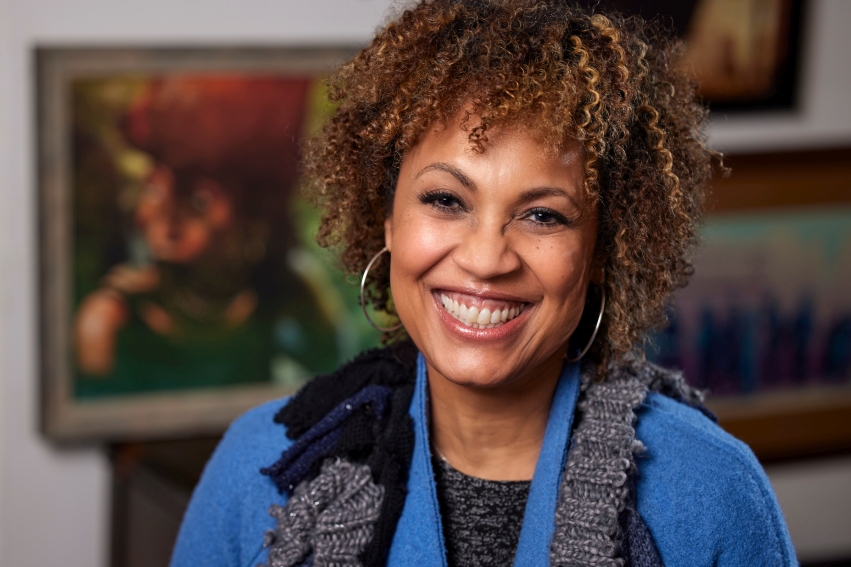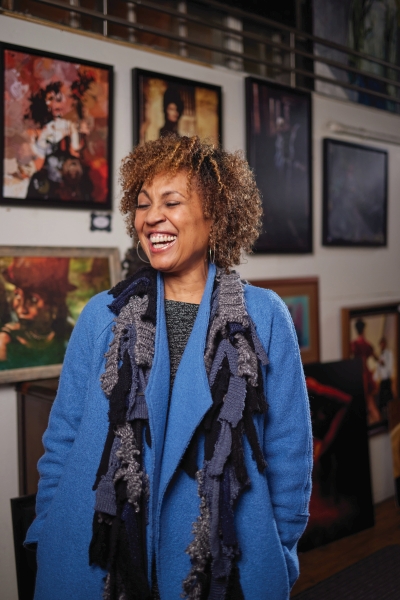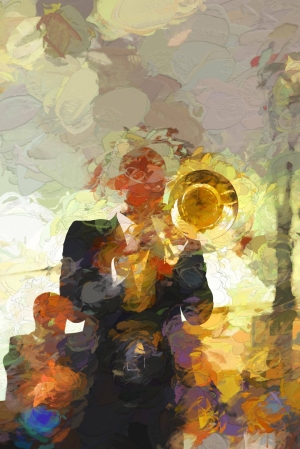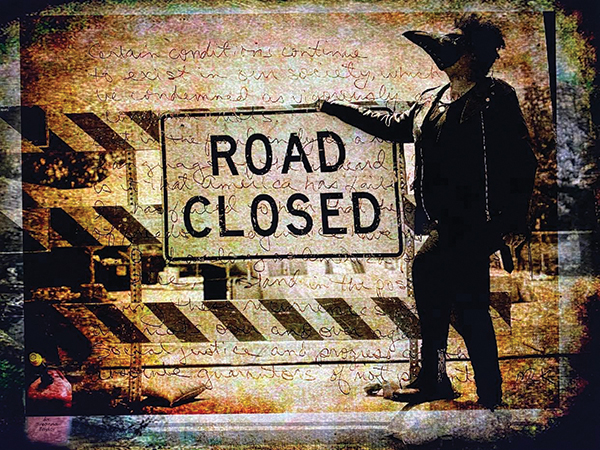
When you’re always behind the camera, it inevitably means that you’re rarely in front of it. Looking back at old family photographs, Natalie Jackson jokes that people often ask why she wasn’t around. “I was there!” she explains cheerfully. “I just took all the photos.”
As the daughter of renowned artist and musician Preston Jackson, Natalie’s life has been filled with art, while taking its own surprising twists and turns. These plot twists have shaped her in unlikely and extraordinary ways, creating a modern-day Renaissance woman. And now, it is long past time to turn the camera around and place Natalie Jackson squarely at its center.
Assortment of Talents
“Early on, my dad worked a later shift than my mom, so he kept us during the day,” Natalie recalls of growing up in Decatur, Illinois, with her sister Alice. “I got to see all kinds of art around me—but one thing I loved the most was his camera.” She watched closely as her father used photographs to inform what he wanted to paint, studying the interplay of shadows and light. “I saw how photography could set a mood.”
Recognizing his daughter’s natural inclination toward photography, Preston gifted her a small Kodak camera. “I was the geeky girl who had a purse full of flashes,” she laughs. “I had a camera everywhere we went.” By the time she was in high school, the family had moved to Peoria.
“That is when I joined the art clubs and won my first art competitions,” Natalie explains. As with the visual arts, music permeated their home—from her father’s guitar practices, to classical and jazz on the stereo. “I used to play classical piano, and then I tried to play jazz. I think that is why I have such an appreciation for jazz,” she muses. “It was very challenging.”
While Preston’s artistic influence on Natalie and her sister is rather conspicuous, their mother, Melba, encouraged their love for literature and art history with her English degree. “My mom went back to school when we were growing up, so I felt like I took all of her courses with her. And when I got to school, I minored in art history.” At this point you might think that Natalie surely majored in art, but here is where our story takes its first unexpected turn.
“I just knew I wanted to be a zoologist,” she says, cracking up with laughter. “I had excellent grades and loved math and science.” She also grew up with a variety of unusual animals in her household, even receiving a boa constrictor on her tenth birthday. “My dad never gave us ‘normal’ animals,” she chuckles. “We had lizards, alligators, a rooster, guinea hens, parrots, piranhas, turtles, snakes… oh my!”
 Meanwhile, her school counselors suggested that Natalie consider engineering, given her talents in math and science. “Believe it or not, I started working for Caterpillar through a mechanical engineering co-op,” she explains. “I sat at a drafting table and loved it because it was drawing. Mechanical drafting was creating art! I was a high school kid working with grown men.”
Meanwhile, her school counselors suggested that Natalie consider engineering, given her talents in math and science. “Believe it or not, I started working for Caterpillar through a mechanical engineering co-op,” she explains. “I sat at a drafting table and loved it because it was drawing. Mechanical drafting was creating art! I was a high school kid working with grown men.”
Soon she was rotating between work and engineering classes at the University of Illinois; but then she shifted gears. Endlessly fascinated by a myriad of subjects, she completed a marketing degree at Bradley while working at IBM through a university co-op program. After graduation, she eventually went back to Caterpillar. With a background in both marketing and engineering, Natalie had a knack for translating complex ideas into language that was easy to understand.
“It was just incredible the things I got to do —teaching classes, traveling to trade shows, meeting people from all over the world... but it was still a man’s world,” she concedes. “And because I was young, I never saw it as, ‘Oh, I am a woman and I'm setting new boundaries!’ Instead, I saw it as ‘They’ve set certain boundaries for me.’ I was the only Black and the only woman. The job stopped giving back to me, and I tired of it.”
It was time for another change of direction. And though she didn’t realize it at the time, she soon would find herself on an unlikely path back to the arts.
Becoming a Photographer
Frustrated, Natalie turned to an industry where she felt she had a better chance to grow in her career: pharmaceuticals. She began traveling around the country, and eventually landed in Atlanta, Georgia. “While I lived in Atlanta, my art just took off!” she notes. While maintaining her full-time job as a pharmaceuticals rep, she went back to school—this time to study photography.
For one of her school projects, Natalie produced a photographic documentary about her hair salon in the trendy Buckhead neighborhood. “For eight weeks I photographed the people who came in… showing that it was this whole community, that it was much more than just a hair salon,” she explains. Out of this project came “Black Beauty,” her first solo exhibition of photography—an artistic celebration of Black hair, Black beauty and Black communities.
As Natalie’s talents became known, she was hired as a staff photographer for an Atlanta-based magazine. Because their offices were situated within her pharmaceutical territory, she could move easily back and forth between jobs. She also frequented the city’s jazz clubs, taking pictures of the musicians in action. She even talked one of the club owners into turning a back storage room into a gallery, showcasing her lifelong fascination in capturing the talents of skilled music-makers.
While still living in Atlanta, Natalie also got involved with the Checkered Raven—her father’s gallery in Peoria, which later evolved into the Contemporary Art Center—and even showed her “Black Beauty” exhibition there. Flying back and forth, she realized she wanted her son to grow up around family, and eventually made the decision to return to the Midwest. But her travel-heavy pharmaceutical schedule still kept her from spending time with him. “I used to [wonder] how people do this when they have a family,” she notes. “And as soon as I had a family, I realized, ‘Oh, they don’t!’”
Then in late 2010, she learned that Soderstrom Skin Institute was seeking to hire a medical photographer—a position that required knowledge of both medicine and photography. “I went into my interview so cocky,” Natalie laughs, well aware of her uniquely eclectic background. With 20 years of photography and pharmaceutical experience under her belt, she was hired on the spot. And she has worked there ever since.
At Soderstrom, Natalie stepped into something bigger than just a job. Dr. Carl Soderstrom and family had a strong background in the arts and welcomed her with open arms—even installing a rotating gallery of her artwork at the Institute. “Doc gave me a gallery in the office!” she exclaims, still somewhat incredulous. “When things line up like that, you just know you’re supposed to be there.
“They say it’s not a job if you love what you’re doing,” she continues. “I feel blessed every day that I get to do what I want to do: photography, 24/7.”

Tapestry of Triumphs
In addition to the gallery at her day job, she opened Natalie Jackson Photography in a space adjacent to her father’s studio at the Contemporary Art Center. She expresses gratitude at the opportunity to work so closely together. “I feel like that is our time. I’m not sharing him with anyone else,” she reveals. “Sometimes you feel like you’re always ‘daddy’s little girl,’ but the fact that my dad is impressed with my art means a lot to me.”
No doubt he’s had ample reason to be proud as Natalie continued to develop her artform. Over the years, she has worked on Jane Fonda’s project to support the Lost Boys of Sudan; had photos published for Art AIDS Africa in Black Enterprise magazine; was one of eight photographers selected to shoot the 2017 New Orleans Jazz & Heritage Festival; and was chosen as one of Sky Art Peoria’s billboard artists in 2019. Her style of photography can be subversive, always beckoning the viewer to investigate further. “Sometimes a photograph is just a photograph, and then other times I decide to put many layers into it,” she explains. “You have to look closely to get the whole thing.”
Natalie also uses her photography as a vehicle for people to learn about Black culture: their history, struggles and triumphs. In her Crowns of Empowerment series, she created mock magazine covers featuring elegantly dressed Black women—but with clashing headlines like: “Coretta’s DREAM HOUSE bombed.” In this case, she wanted to invoke the fear and intimidation experienced when Coretta and Dr. Martin Luther King, Jr.’s home was bombed by segregationists. “Crowns depicts fighting for basic human rights through the eyes of the Black woman. I hoped to teach and give the audience a glimpse of what she feels, since she is often dismissed.”
Everything intensified in 2020, of course. During this year of a global pandemic, protests for racial justice, political turmoil and personal challenges, Natalie was forced to grapple with a range of difficult emotions. It was a year that appropriately gave life to her And Still I Rise exhibit at the Peoria Public Library. “I may fall and I may stumble—but I still get back up,” she declares.
The exhibit’s title was inspired by Maya Angelou’s poem of the same name, which she printed in the exhibit’s program. “To encourage you—even if it was the pandemic, if it was relationships, if it was the loss of a job—that we’re not beat; we fight and we go on,” she explains. “It’s a message to everyone, but [especially] to Black women. We continually struggle, but we know we can’t just lie there. We keep on moving.”
Swirling within this tapestry of history, style, culture and commentary, the artist asks viewers to consider many things—from coming to grips with our true American history, to the reality of how Black women are disrespected, to what it is like to raise a Black child. In one particularly striking photograph, a model dons a plague mask near a road closure sign. Using digital layering, Natalie placed a small gasoline can in the corner that reads “For Breonna Taylor,” while another layer incorporates quotes from Dr. King expressing weariness over peaceful protests that leave Black voices unheard. “But the culminating point is that we still rise, in spite of it all.”

Freedom’s Rise
Besides increasing her online presence in 2021, Natalie is excited to announce that she soon will open a photography studio in north Peoria. At NatJack Studios, she plans to focus on her love of portraits—her “bread and butter,” she explains—while using her photography to lift up women and reveal their beauty. Talking through her plans, she is clearly joyous about the opportunities that lie ahead. She also has returned to the conclusion that she must pursue art for herself and no one else—a lesson she first learned from her father.
“When I moved here, I started shooting things that I thought people would buy… and it was so boring!” she concedes. “I have to do art for myself. If I don’t have passion for it, then I can’t evoke that passion from somebody else. If I’m shooting a musician, it’s because I’m enjoying the music so much. I am hoping that you get to experience the same thing that I’m feeling.”
And after all that she has gone through, what does her artwork mean to her these days? “Freedom, freedom, freedom! I rise, I rise, I rise!” she exclaims. “It just lets me be me. That’s what I love about it.” PM
For more information, visit nataliejacksonphotography.com.
- Log in to post comments

